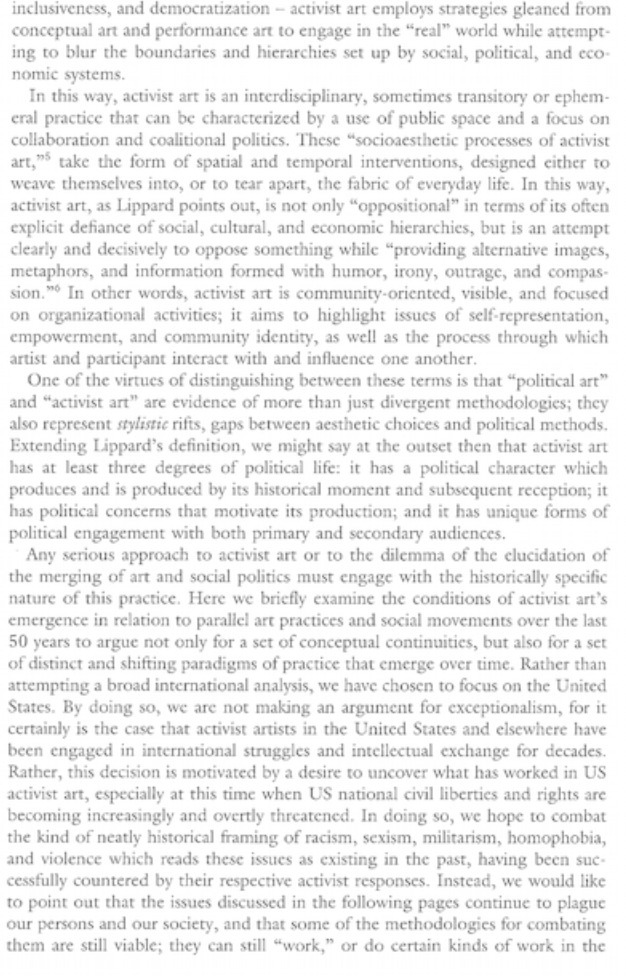inclusiveness, and democratization - activist art employs strategies gleaned from conceptual art and performance art to engage in the "real" world while attempt- ing to blur the boundaries and hierarchies set up by social, political, and eco- nomic systems. In this way, activist art is an interdisciplinary, sometimes transitory or ephem- eral practice that can be characterized by a use of public space and a focus on collaboration and coalitional politics. These "socioaesthetic processes of activist art,"'s take the form of spatial and temporal interventions, designed either to weave themselves into, or to tear apart, the fabric of everyday life. In this way, activist art, as Lippard points out, is not only "oppositional" in terms of its often explicit defiance of social, cultural, and economic hierarchies, but is an attempt clearly and decisively to oppose something while "providing alternative images, metaphors, and information formed with humor, irony, outrage, and compas- sion. " In other words, activist art is community-oriented, visible, and focused on organizational activities; it aims to highlight issues of self-representation, empowerment, and community identity, as well as the process through which artist and participant interact with and influence one another. One of the virtues of distinguishing between these terms is that "political art" and "activist art" are evidence of more than just divergent methodologies; they also represent stylistic rifts, gaps between aesthetic choices and political methods. Extending Lippard's definition, we might say at the outset then that activist art has at least three degrees of political life: it has a political character which produces and is produced by its historical moment and subsequent reception; it has political concerns that motivate its production; and it has unique forms of political engagement with both primary and secondary audiences. Any serious approach to activist art or to the dilemma of the elucidation of the merging of art and social politics must engage with the historically specific nature of this practice. Here we briefly examine the conditions of activist art's emergence in relation to parallel art practices and social movements over the last 50 years to argue not only for a set of conceptual continuities, but also for a set of distinct and shifting paradigms of practice that emerge over time. Rather than attempting a broad international analysis, we have chosen to focus on the United States. By doing so, we are not making an argument for exceptionalism, for it certainly is the case that activist artists in the United States and elsewhere have been engaged in international struggles and intellectual exchange for decades. Rather, this decision is motivated by a desire to uncover what has worked in US activist art, especially at this time when US national civil liberties and rights are becoming increasingly and overtly threatened. In doing so, we hope to combat the kind of neatly historical framing of racism, sexism, militarism, homophobia, and violence which reads these issues as existing in the past, having been suc- cessfully countered by their respective activist responses. Instead, we would like to point out that the issues discussed in the following pages continue to plague our persons and our society, and that some of the methodologies for combating them are still viable; they can still "work," or do certain kinds of work in the







